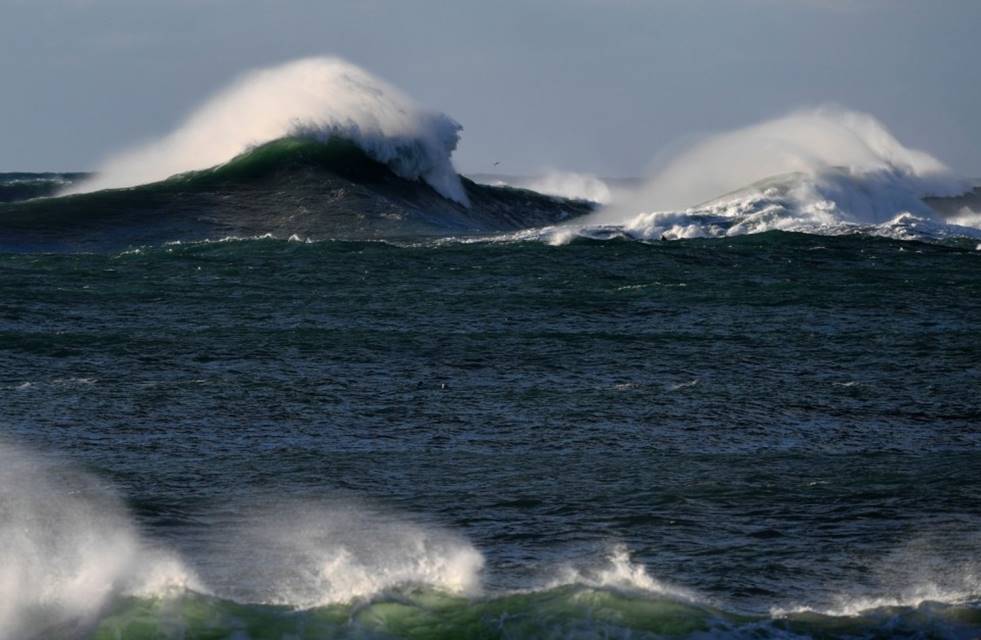Na água do mar, o oxigênio existe em concentrações que variam, segundo a temperatura e a salinidade, entre 6ml/l e 8,5 ml/l. O termo hipóxia aplica-se quando a concentração de oxigênio é menor que 2 ml/l e o termo anóxia, quando essa concentração é menor que 0,5 ml/l. Nessas condições, os peixes que não fogem a tempo tendem a perder sua orientação, desmaiam e morrem asfixiados. Os organismos que não conseguem se locomover em velocidade, como os crustáceos, e os que vivem fixos em outras estruturas morrem em sua totalidade e sua putrefação retroalimenta positivamente, via respiração bacterial, a hipóxia e a anóxia.
Fenômenos de hipóxia ou anóxia podem ocorrer naturalmente, mas são raros, em pequena escala e apenas sazonais. Os fatores antrópicos transformam-nos em fenômenos frequentes e crescentes, de larga escala e, por vezes, permanentes. Uma zona anóxica torna-se, assim, um cemitério marinho onde não há lugar para vertebrados e outras formas de vida multicelular. Sua proliferação em áreas costeiras muito povoadas vem sendo observada desde os anos 1970. Segundo Robert J. Diaz, do Virginia Institute of Marine Science, elas têm aproximadamente dobrado a cada década. Mas entre 2003 e 2011, ela mais que triplicou. O GEO Year Book 2013 do UNEP reporta 146 zonas mortas (creeping dead zones), muitas de pequeno porte e a maior delas estendendo-se por uma área de 70 mil quilômetros quadrados.
Em 2008, outro estudo contava já 405 zonas mortas, cobrindo uma área de 246 mil quilômetros quadrados. Em 2011, o World Resources Institute e o Virginia Institute of Marine Science identificaram 530 zonas mortas e 228 zonas exibindo sinais de eutrofização marinha. Alguns dos casos mais agudos de zonas mortas são o Adriático Norte, a Chesapeake Bay nos Estados Unidos, uma área de mais de 18 mil km2 do litoral norte do Golfo do México, a foz do Mississipi, a Baía de Tóquio, certas zonas marítimas que banham a China, o Japão, o sudeste da Austrália e a Nova Zelândia, bem como o Golfo de Cariaco na Venezuela. Outras zonas mortas maiores do oceano encontram-se em partes do Mar do Norte, do Mar Báltico e no estreito de Kattegat, entre a Dinamarca e a Suécia.
Em 2012, Osvaldo Ulloa, do Centro de Investigación Oceanográfica Copas da Universidad de Concepción no Chile, observou o surgimento de novas zonas anóxicas na costa de Iquique, no norte do Chile. Segundo Ulloa, antes desse estudo não se pensava que pudessem existir áreas completamente sem oxigênio em mar aberto, e ainda menos em níveis tão próximos da superfície: “os peixes perdem seu habitat e morrem ou se distanciam, pois não são capazes de sobreviver. Só os micro-organismos, principalmente bactérias e arqueias podem subsistir”. Para Ulloa, a região de Biobó, no mar meridional do Chile poderá ser a próxima a sofrer de anóxia, pois se descobriram nessa zona costeira no verão e no começo do outono de 2012 águas desprovidas de oxigênio.
O artigo abaixo mostra que a perda de oxigênio dissolvido no oceano é um fenômeno generalizado, em grande parte como consequência das mudanças climáticas e do consequente aquecimento dos estratos superiores do oceano.
Luiz Marques
A large research synthesis, published in one of the world’s most influential scientific journals, has detected a decline in the amount of dissolved oxygen in oceans around the world — a long-predicted result of climate change that could have severe consequences for marine organisms if it continues.
The paper, published Wednesday in the journal Nature by oceanographer Sunke Schmidtko and two colleagues from the GEOMAR Helmholtz Centre for Ocean Research in Kiel, Germany, found a decline of more than 2 percent in ocean oxygen content worldwide between 1960 and 2010. The loss, however, showed up in some ocean basins more than others. The largest overall volume of oxygen was lost in the largest ocean — the Pacific — but as a percentage, the decline was sharpest in the Arctic Ocean, a region facing Earth’s most stark climate change.
The loss of ocean oxygen “has been assumed from models, and there have been lots of regional analysis that have shown local decline, but it has never been shown on the global scale, and never for the deep ocean,” said Schmidtko, who conducted the research with Lothar Stramma and Martin Visbeck, also of GEOMAR.
Ocean oxygen is vital to marine organisms, but also very delicate — unlike in the atmosphere, where gases mix together thoroughly, in the ocean that is far harder to accomplish, Schmidtko explained. Moreover, he added, just 1 percent of all the Earth’s available oxygen mixes into the ocean; the vast majority remains in the air.
Climate change models predict the oceans will lose oxygen because of several factors. Most obvious is simply that warmer water holds less dissolved gases, including oxygen. “It’s the same reason we keep our sparkling drinks pretty cold,” Schmidtko said.
But another factor is the growing stratification of ocean waters. Oxygen enters the ocean at its surface, from the atmosphere and from the photosynthetic activity of marine microorganisms. But as that upper layer warms up, the oxygen-rich waters are less likely to mix down into cooler layers of the ocean because the warm waters are less dense and do not sink as readily.
“When the upper ocean warms, less water gets down deep, and so therefore, the oxygen supply to the deep ocean is shut down or significantly reduced,” Schmidtko said.
The new study represents a synthesis of literally “millions” of separate ocean measurements over time, according to GEOMAR. The authors then used interpolation techniques for areas of the ocean where they lacked measurements.
The resulting study attributes less than 15 percent of the total oxygen loss to sheer warmer temperatures, which create less solubility. The rest was attributed to other factors, such as a lack of mixing.
Matthew Long, an oceanographer from the National Center for Atmospheric Research who has published on ocean oxygen loss, said he considers the new results “robust” and a “major advance in synthesizing observations to examine oxygen trends on a global scale.”
Long was not involved in the current work, but his research had previously demonstrated that ocean oxygen loss was expected to occur and that it should soon be possible to demonstrate that in the real world through measurements, despite the complexities involved in studying the global ocean and deducing trends about it.
That’s just what the new study has done.
“Natural variations have obscured our ability to definitively detect this signal in observations,” Long said in an email. “In this study, however, Schmidtko et al. synthesize all available observations to show a global-scale decline in oxygen that conforms to the patterns we expect from human-driven climate warming. They do not make a definitive attribution statement, but the data are consistent with and strongly suggestive of human-driven warming as a root cause of the oxygen decline.
“It is alarming to see this signal begin to emerge clearly in the observational data,” he added.
“Schmidtko and colleagues’ findings should ring yet more alarm bells about the consequences of global warming,” added Denis Gilbert, a researcher with the Maurice Lamontagne Institute at Fisheries and Oceans Canada in Quebec, in an accompanying commentary on the study also published in Nature.
Because oxygen in the global ocean is not evenly distributed, the 2 percent overall decline means there is a much larger decline in some areas of the ocean than others.
Moreover, the ocean already contains so-called oxygen minimum zones, generally found in the middle depths. The great fear is that their expansion upward, into habitats where fish and other organism thrive, will reduce the available habitat for marine organisms.
In shallower waters, meanwhile, the development of ocean “hypoxic” areas, or so-called “dead zones,” may also be influenced in part by declining oxygen content overall.
On top of all of that, declining ocean oxygen can also worsen global warming in a feedback loop. In or near low oxygen areas of the oceans, microorganisms tend to produce nitrous oxide, a greenhouse gas, Gilbert writes. Thus the new study “implies that production rates and efflux to the atmosphere of nitrous oxide … will probably have increased.”
The new study underscores once again that some of the most profound consequences of climate change are occurring in the oceans, rather than on land. In recent years, incursions of warm ocean water have caused large die-offs of coral reefs, and in some cases, kelp forests as well. Meanwhile, warmer oceans have also begun to destabilize glaciers in Greenland and Antarctica, and as they melt, these glaciers freshen the ocean waters and potentially change the nature of their circulation.
When it comes to ocean deoxygenation, as climate change continues, this trend should also increase — studies suggest a loss of up to 7 percent of the ocean’s oxygen by 2100. At the end of the current paper, the researchers are blunt about the consequences of a continuing loss of oceanic oxygen.
“Far-reaching implications for marine ecosystems and fisheries can be expected,” they write.


